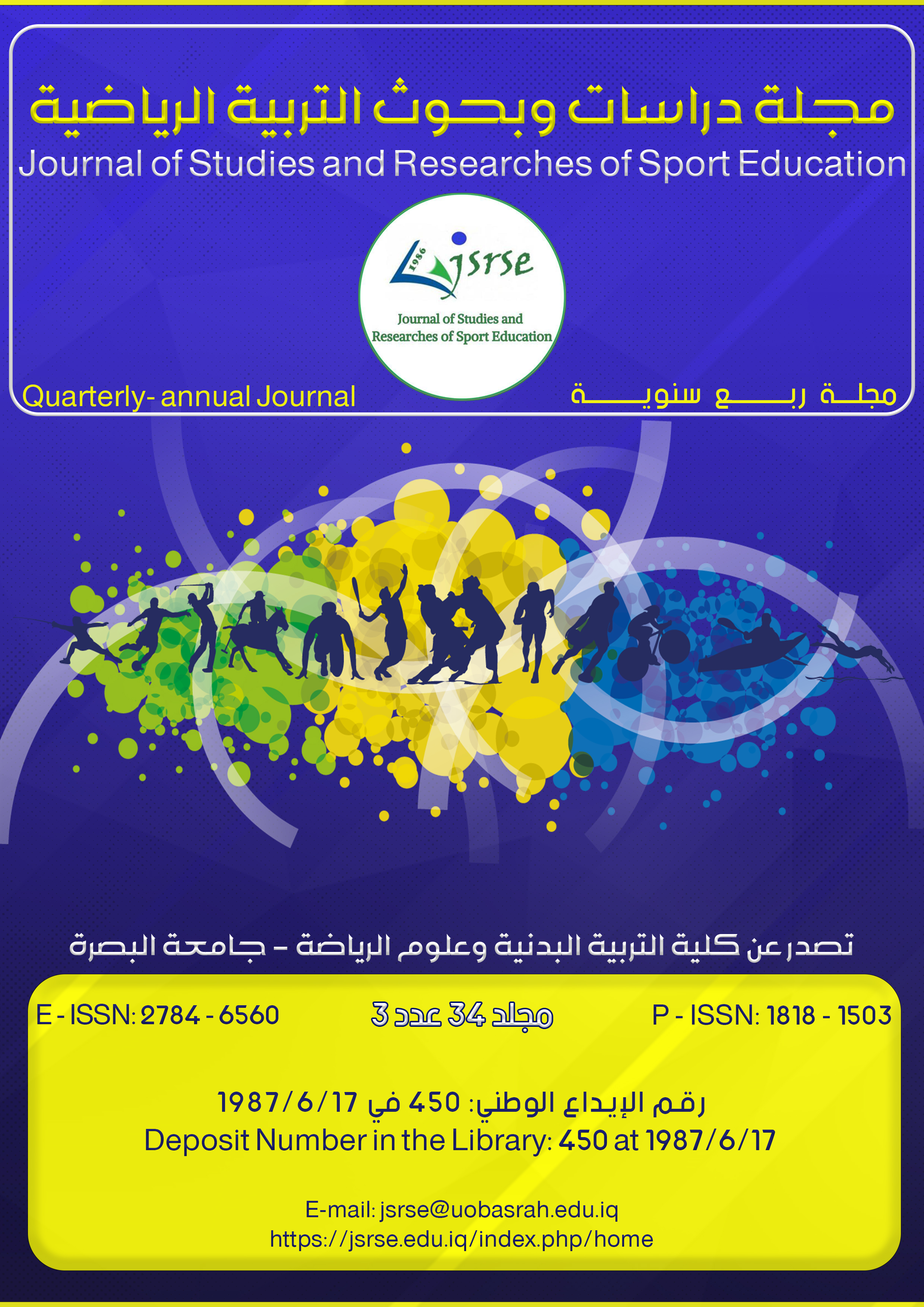Construction and Validation of a Cognitive Engagement Scale and Its Relationship with Ball Movement Sequence Performance in Rhythmic Gymnastics
محتوى المقالة الرئيسي
الملخص
The research aims to: build and record a measure of cognitive participation among second-year female students at the College of Physical Education and Sports Sciences, University of Baghdad. The researchers used the descriptive approach in the survey style for the research sample. The sample was selected from female students and divided into: (10) female students for the survey sample, and (80) female students for the construction and codification sample. The data were statistically analyzed by the researchers using SPSS, the T-test for independent and correlated samples, Pearson's simple correlation coefficient, Cronbach's alpha, Chi-square, and Spearman-Brown. They were recruited for the samples. The study concluded that constructing a measure of cognitive participation for students in the second stage could be applied through the ease and difficulty of its expressions that are appropriate to the research sample, as well as the grades and levels that were reached, which showed that the sample fell within the rating (good and acceptable), and on the other hand the sample was characterized by participation. Cognitive through the results of the scale and its four axes. In conclusion, cognitive participation plays a positive role in performing the ball movement sequence in rhythmic gymnastics.
تفاصيل المقالة

هذا العمل مرخص بموجب Creative Commons Attribution-NonCommercial 4.0 International License.
المراجع
Abdulrasool, T. H., Hussein, R. A. A., & Aldewan, L. H. M. (2024). A proposed vision for developing the structure of physical education curriculum within the framework of digital giving and technologies of the age of artificial intelligence. International Journal of Physiology, Sports and Physical Education, 6(1), 19–28. https://doi.org/10.33545/26647710.2024.v6.i1a.61
Ahmed Obaid, M., Hussein Khalifa, A., & Saad Rabeea, M. (n.d.). The Effect of an Electronic Device Designed to Measure the Knee Bending Angle in Developing the Skill of Catch and Clearance the High Ball for Football Goalkeepers. Annals of Applied Sport Science, 0. Retrieved June 5, 2024, from http://dx.doi.org/10.61186/aassjournal.1286
Connelly, C. E., & Kevin Kelloway, E. (2003). Predictors of employees’ perceptions of knowledge sharing cultures. Leadership & Organization Development Journal, 24(5), 294–301.
Fadil, A. H., & Mohammed, K. S. (2022). Constructing and Rationing A Test for the Skill of Receiving the Serve From Above in Volleyball for Third-Year Students in the Faculty of Physical Education and Sports Sciences. Revista Iberoamericana de Psicología Del Ejercicio y El Deporte, 17(3), 140–142.
Ghazi, M. A., Abd, M., Kadhim, A., Hasan Aldewan, L., Jawad, S., & Almayah, K. (2024). Facial fingerprint analysis using artificial intelligence techniques and its ability to respond quickly during karate (kumite). JOURNAL OF HUMAN SPORT & EXERCISE. https://doi.org/10.14198/jhse.2024.192.20
Haseeb, H. R., & Laith, K. (2022). The Effect of a tool for helping the learning of forehand and backhand stroke in tennis for ages (10-15). Journal of Physical Education, 34(4).
Hassoun, I. A., & Jassim, Z. K. (2019). Attentional control and its relationship to some ground movements in gymnastics devices. Al. Qadisiya Journal for the Sciences of Physical Education, 19(1 part (2)).
Hummadi, J. N., Mushref, A. J., Awad, A. K., & Ali, O. A. (2024). The effect of special exercises on developing some coordination abilities and improving the level of performance of both open and wide jumping skills on the artistic gymnastics vaulting table for men. Journal of Studies and Researches of Sport Education, 34(1).
Jasem, Z. K., Naser, A. J., & Hadi, A. M. (2023). The Effect of Transferring Positive and Negative Energy in Evaluating The Performance of Some Kinetic Skills in Rhythmic Gymnastics. Revista Iberoamericana de Psicología Del Ejercicio y El Deporte, 18(2), 190–193.
Kadhim, M. A. A., Mashi, A. A. A., Al-Diwan, L. H., & Ghazi, M. A. (2024). Understanding the Mechanism of Conducting Benchmark Test for the Infrastructure of Physical Education Curricula in the Age of Artificial Intelligence. International Journal of Elementary Education, 13(1), 8–12. https://doi.org/10.11648/j.ijeedu.20241301.12
Khaled Jasem, Z. (2024). Communicative Intelligence and Its Relationship to the Performance of the Kinetic Formation of the Hoop in Rhythmic Gymnastics. Annals of Applied Sport Science, 12(1), 0.
Khalifab, M., & Jabbar, R. H. (2023). The effect of an electronic device designed to measure the degree of bending of the knee angle in developing the skill of catch and Clearance the high ball for football goalkeepers under (15 years). J Xi’an Shiyou Univ Nat Sci Ed, 19(11), 751–764.
Mohammed, K. S. (2019). Self-confidence and its relation to the performance of skill and compare them to volleyball players of elite clubs according to their specialization. Karbala Journal of Physical Education Sciences, 5(2).
Mohammed, K. S., Flayyih, M. S., & Rumeeh, A. F. (2020). Building and codifying a scale of the level of tactical performance of advanced volleyball players. International Journal of Psychosocial Rehabilitation, 24(10).
Mohammed, K. S., Shamkhi, D. A., & Mohammed, M. J. (2023). Determining the grades and standard levels of some mental skills as an indicator for the selection of young volleyball players. SPORT TK-Revista EuroAmericana de Ciencias Del Deporte, 28.
Mukhlif, M. M., & Maleh, F. A. (2019). The effect of special exercises on some sensory-motor abilities and the performance of the motor chain with the ball in rhythmic gymnastics. Sports Science Journal, 11(39), 109. https://doi.org/10.26400/sp/39/8
Munaf, S. M., Ali, A. A., & Mohammed, K. S. (2021). BUILDING AND RATIONING SCALE MANAGEMENT CONSTRAINTS OF E-LEARNING FROM THE PERSPECTIVE OF TEACHING THE FACULTY OF PHYSICAL EDUCATION AND SPORTS SCIENCE UNIVERSITY OF BAGHDAD. Turkish Journal of Physiotherapy and Rehabilitation, 32, 3.
Naser, A. J., & Jasim, Z. K. (2021). Relationship between Cognitive style (risk taking VS Cautiousness) and performance of some ring skills for third stage female students in College of Physical Education and Sport Sciences/University of Baghdad. Mustansiriyah Journal of Sports Science, 3(2), 112–120.
Sabah, A. A., & Jasem, Z. K. (2023). Cognitive Flexibility of Football Coaches from the Standpoint of Iraqi Premier League Players. Pakistan Heart Journal, 56(2), 234–247.





 IASJ
IASJ CC-BY-4.0
CC-BY-4.0 turnitin
turnitin ISSN
ISSN DOAJ
DOAJ Crossref
Crossref GoogleScholar
GoogleScholar Orcid
Orcid